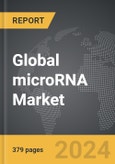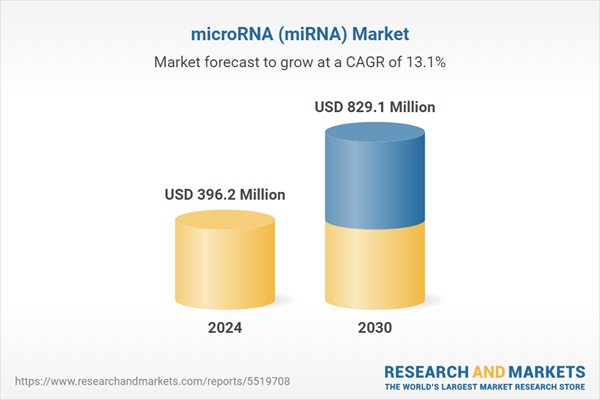The global market for microRNA (miRNA) was valued at US$396.2 Million in 2024 and is projected to reach US$829.1 Million by 2030, growing at a CAGR of 13.1% from 2024 to 2030. This comprehensive report provides an in-depth analysis of market trends, drivers, and forecasts, helping you make informed business decisions. The report includes the most recent global tariff developments and how they impact the microRNA (miRNA) market.
Research into miRNAs has burgeoned, revealing their potential as biomarkers for disease diagnosis and prognosis, as well as targets for therapeutic intervention. Tools and technologies to study miRNAs have also evolved, ranging from advanced sequencing techniques to bioinformatics tools designed to predict miRNA targets and functions. In the clinical context, miRNA-based diagnostics have shown promise in identifying specific miRNAs associated with particular disease states, which can lead to early detection and more personalized treatment plans. Moreover, miRNA therapeutics, which aim to modulate the function of specific miRNAs, are in development, with several candidates in preclinical and clinical trials. These therapeutic strategies include miRNA mimics, which are synthetic miRNAs designed to restore normal function to cells, and miRNA inhibitors, which block the function of miRNAs involved in disease progression.
The growth in the miRNA market is driven by several factors, including advances in miRNA profiling technologies, increased investment in miRNA research and therapeutic development, and a growing awareness of the potential of miRNAs in precision medicine. Technological advancements have led to more efficient and cost-effective methods for detecting and quantifying miRNAs, enhancing their applicability in both research and clinical settings. The pharmaceutical and biotechnological sectors are increasingly focusing on developing miRNA-based therapeutics, attracted by their ability to target multiple aspects of disease pathways. Moreover, as the healthcare industry moves toward more personalized treatment options, the demand for miRNA diagnostics and therapeutics is expected to rise, reflecting their potential to tailor treatments to individual genetic profiles and disease conditions. This trend is bolstered by a growing body of research that links specific miRNAs to particular diseases, further underpinning the clinical value of miRNAs as both biomarkers and therapeutic targets.
Segments: Type (Products, Services); Application (Cancer, Infectious Diseases, Immunological Disorders, Cardiovascular Diseases, Neurological Diseases, Other Applications); End-Use (Academic & Government Research Institutes, Biotech & Pharma Companies, Other End-Uses).
Geographic Regions/Countries: World; USA; Canada; Japan; China; Europe; France; Germany; Italy; UK; Rest of Europe; Asia-Pacific; Rest of World.
The analysts continuously track trade developments worldwide, drawing insights from leading global economists and over 200 industry and policy institutions, including think tanks, trade organizations, and national economic advisory bodies. This intelligence is integrated into forecasting models to provide timely, data-driven analysis of emerging risks and opportunities.
Global microRNA (miRNA) Market - Key Trends and Drivers Summarized
MicroRNAs (miRNAs) are a class of small, non-coding RNA molecules that play a crucial role in regulating gene expression at the post-transcriptional level. Typically about 22 nucleotides long, miRNAs bind to complementary sequences on target messenger RNA (mRNA) transcripts, usually resulting in gene silencing via translational repression or target degradation. The discovery of miRNAs has significantly advanced our understanding of how genes are regulated in cells and has implications for a wide range of biological processes including development, differentiation, and metabolism. Given their involvement in various cellular pathways, miRNAs are also considered vital in the pathology of numerous diseases, notably cancer, cardiovascular diseases, and neurodegenerative disorders.Research into miRNAs has burgeoned, revealing their potential as biomarkers for disease diagnosis and prognosis, as well as targets for therapeutic intervention. Tools and technologies to study miRNAs have also evolved, ranging from advanced sequencing techniques to bioinformatics tools designed to predict miRNA targets and functions. In the clinical context, miRNA-based diagnostics have shown promise in identifying specific miRNAs associated with particular disease states, which can lead to early detection and more personalized treatment plans. Moreover, miRNA therapeutics, which aim to modulate the function of specific miRNAs, are in development, with several candidates in preclinical and clinical trials. These therapeutic strategies include miRNA mimics, which are synthetic miRNAs designed to restore normal function to cells, and miRNA inhibitors, which block the function of miRNAs involved in disease progression.
The growth in the miRNA market is driven by several factors, including advances in miRNA profiling technologies, increased investment in miRNA research and therapeutic development, and a growing awareness of the potential of miRNAs in precision medicine. Technological advancements have led to more efficient and cost-effective methods for detecting and quantifying miRNAs, enhancing their applicability in both research and clinical settings. The pharmaceutical and biotechnological sectors are increasingly focusing on developing miRNA-based therapeutics, attracted by their ability to target multiple aspects of disease pathways. Moreover, as the healthcare industry moves toward more personalized treatment options, the demand for miRNA diagnostics and therapeutics is expected to rise, reflecting their potential to tailor treatments to individual genetic profiles and disease conditions. This trend is bolstered by a growing body of research that links specific miRNAs to particular diseases, further underpinning the clinical value of miRNAs as both biomarkers and therapeutic targets.
Report Scope
The report analyzes the microRNA (miRNA) market, presented in terms of units. The analysis covers the key segments and geographic regions outlined below.Segments: Type (Products, Services); Application (Cancer, Infectious Diseases, Immunological Disorders, Cardiovascular Diseases, Neurological Diseases, Other Applications); End-Use (Academic & Government Research Institutes, Biotech & Pharma Companies, Other End-Uses).
Geographic Regions/Countries: World; USA; Canada; Japan; China; Europe; France; Germany; Italy; UK; Rest of Europe; Asia-Pacific; Rest of World.
Key Insights:
- Market Growth: Understand the significant growth trajectory of the Products segment, which is expected to reach US$411.8 Million by 2030 with a CAGR of a 11.4%. The Services segment is also set to grow at 14.9% CAGR over the analysis period.
- Regional Analysis: Gain insights into the U.S. market, valued at $154.3 Million in 2024, and China, forecasted to grow at an impressive 16.3% CAGR to reach $88.2 Million by 2030. Discover growth trends in other key regions, including Japan, Canada, Germany, and the Asia-Pacific.
Why You Should Buy This Report:
- Detailed Market Analysis: Access a thorough analysis of the Global microRNA (miRNA) Market, covering all major geographic regions and market segments.
- Competitive Insights: Get an overview of the competitive landscape, including the market presence of major players across different geographies.
- Future Trends and Drivers: Understand the key trends and drivers shaping the future of the Global microRNA (miRNA) Market.
- Actionable Insights: Benefit from actionable insights that can help you identify new revenue opportunities and make strategic business decisions.
Key Questions Answered:
- How is the Global microRNA (miRNA) Market expected to evolve by 2030?
- What are the main drivers and restraints affecting the market?
- Which market segments will grow the most over the forecast period?
- How will market shares for different regions and segments change by 2030?
- Who are the leading players in the market, and what are their prospects?
Report Features:
- Comprehensive Market Data: Independent analysis of annual sales and market forecasts in US$ Million from 2024 to 2030.
- In-Depth Regional Analysis: Detailed insights into key markets, including the U.S., China, Japan, Canada, Europe, Asia-Pacific, Latin America, Middle East, and Africa.
- Company Profiles: Coverage of players such as Agilent Technologies, Inc., Bio-Rad Laboratories, Inc., Abcam PLC, BioVendor - Laboratorni medicina a.s, GeneCopoeia, Inc. and more.
- Complimentary Updates: Receive free report updates for one year to keep you informed of the latest market developments.
Some of the 64 companies featured in this microRNA (miRNA) market report include:
- Agilent Technologies, Inc.
- Bio-Rad Laboratories, Inc.
- Abcam PLC
- BioVendor - Laboratorni medicina a.s
- GeneCopoeia, Inc.
- AKESOgen, Inc.
- Entos Pharmaceuticals
- Genomnia
- Guangzhou Ruibo Biotechnology Co., Ltd.
- 20Med Therapeutics
- AceRNA Technologies Co., Ltd.
- AptamiR Therapeutics
- Causeway Therapeutics
- Cardior Pharmaceuticals
- Craif
Tariff Impact Analysis: Key Insights for 2025
Global tariff negotiations across 180+ countries are reshaping supply chains, costs, and competitiveness. This report reflects the latest developments as of April 2025 and incorporates forward-looking insights into the market outlook.The analysts continuously track trade developments worldwide, drawing insights from leading global economists and over 200 industry and policy institutions, including think tanks, trade organizations, and national economic advisory bodies. This intelligence is integrated into forecasting models to provide timely, data-driven analysis of emerging risks and opportunities.
What’s Included in This Edition:
- Tariff-adjusted market forecasts by region and segment
- Analysis of cost and supply chain implications by sourcing and trade exposure
- Strategic insights into geographic shifts
Buyers receive a free July 2025 update with:
- Finalized tariff impacts and new trade agreement effects
- Updated projections reflecting global sourcing and cost shifts
- Expanded country-specific coverage across the industry
Table of Contents
I. METHODOLOGYII. EXECUTIVE SUMMARY2. FOCUS ON SELECT PLAYERSAN INSIGHT INTO MIRNA APPLICATIONSKIDNEY DISEASEALCOHOLISMOBESITYHEMOSTASISIII. MARKET ANALYSISCANADAITALYREST OF EUROPEREST OF WORLDIV. COMPETITION
1. MARKET OVERVIEW
3. MARKET TRENDS & DRIVERS
CANCER
HEART DISEASE
NERVOUS SYSTEM
4. GLOBAL MARKET PERSPECTIVE
UNITED STATES
JAPAN
CHINA
EUROPE
FRANCE
GERMANY
UNITED KINGDOM
ASIA-PACIFIC
Companies Mentioned (Partial List)
A selection of companies mentioned in this report includes, but is not limited to:
- Agilent Technologies, Inc.
- Bio-Rad Laboratories, Inc.
- Abcam PLC
- BioVendor - Laboratorni medicina a.s
- GeneCopoeia, Inc.
- AKESOgen, Inc.
- Entos Pharmaceuticals
- Genomnia
- Guangzhou Ruibo Biotechnology Co., Ltd.
- 20Med Therapeutics
- AceRNA Technologies Co., Ltd.
- AptamiR Therapeutics
- Causeway Therapeutics
- Cardior Pharmaceuticals
- Craif
Table Information
| Report Attribute | Details |
|---|---|
| No. of Pages | 379 |
| Published | April 2025 |
| Forecast Period | 2024 - 2030 |
| Estimated Market Value ( USD | $ 396.2 Million |
| Forecasted Market Value ( USD | $ 829.1 Million |
| Compound Annual Growth Rate | 13.1% |
| Regions Covered | Global |









